Ever wondered about the difference between sunny side up and over hard eggs? These two egg cooking styles have their own special traits. Sunny side up eggs are cooked on one side, while over hard eggs are cooked on both sides. But what makes them unique, and how do you pick between them?
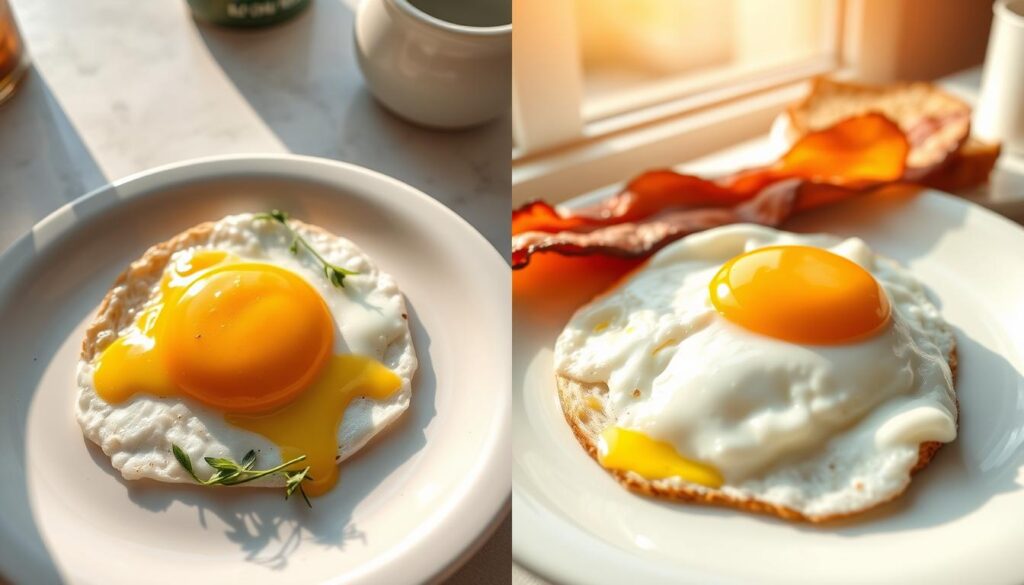
Knowing the difference between sunny side up and over hard eggs can guide your egg cooking choices. Whether you love breakfast or want to spice up your mornings, understanding each style can make cooking more fun.
Key Takeaways
- You will learn about the unique characteristics of sunny side up and over hard eggs.
- Understanding the cooking methods and textures of each style will help you make informed decisions.
- Sunny side up eggs are cooked on one side, while over hard eggs are cooked on both sides.
- The difference between sunny side up and over hard eggs lies in their cooking techniques and resulting flavors.
- Knowing the characteristics of each style can enhance your cooking experience and help you choose the perfect eggs for your meal.
- You will discover how to cook sunny side up and over hard eggs to perfection.
Introduction to Fried Egg Styles -sunny side up vs over hard eggs-
Fried eggs have been a favorite for centuries in many cuisines. You can try different egg cooking styles to find your favorite. Each style, from sunny side up to over hard, brings a unique taste and texture.
Exploring fried eggs, you’ll find many options to match your taste. Whether you prefer eggs runny or well-done, there’s a style for you.
To understand egg cooking styles, knowing basic terms is key. Here’s a quick guide to get you started:
- Egg doneness levels: runny, over easy, over medium, over hard
- Cooking methods: pan-frying, poaching, boiling
- Egg types: large, extra-large, jumbo
Brief History of Fried Eggs -sunny side up vs over hard eggs-
Fried eggs have a long history, dating back to ancient times. Cooking eggs has evolved, with many cultures adding their own styles and techniques.
Understanding Egg Doneness Levels
Egg doneness levels range from runny to well-done. Knowing these levels helps you get the texture and taste you want.
Basic Terminology You Should Know
Learning basic egg cooking terms will make you more confident in cooking breakfast eggs. From cooking methods to egg types, knowing these terms will improve your cooking.
| Egg Doneness Level | Description |
|---|---|
| Runny | Eggs with a liquid yolk and a set white |
| Over Easy | Eggs with a slightly firmer yolk and a set white |
| Over Medium | Eggs with a firmer yolk and a set white |
| Over Hard | Eggs with a fully set yolk and white |
What is the Difference Between Sunny Side Up and Over Hard Eggs?
Two popular egg styles are sunny side up and over hard eggs. The main difference is in how they are cooked and their texture. You might ask, what’s the difference between sunny side up and over hard eggs? It’s all about the cooking method and the final egg.
Sunny side up eggs are cooked on one side, with a runny yolk. Over hard eggs are cooked on both sides, with a fully set yolk. This cooking difference changes the egg’s texture and taste, making each style unique.
When preparing these eggs, consider a few things:
- Cooking time and temperature
- Egg freshness and quality
- Heat distribution and pan type
These factors make sunny side up and over hard eggs different. Each is a tasty choice for breakfast or brunch.
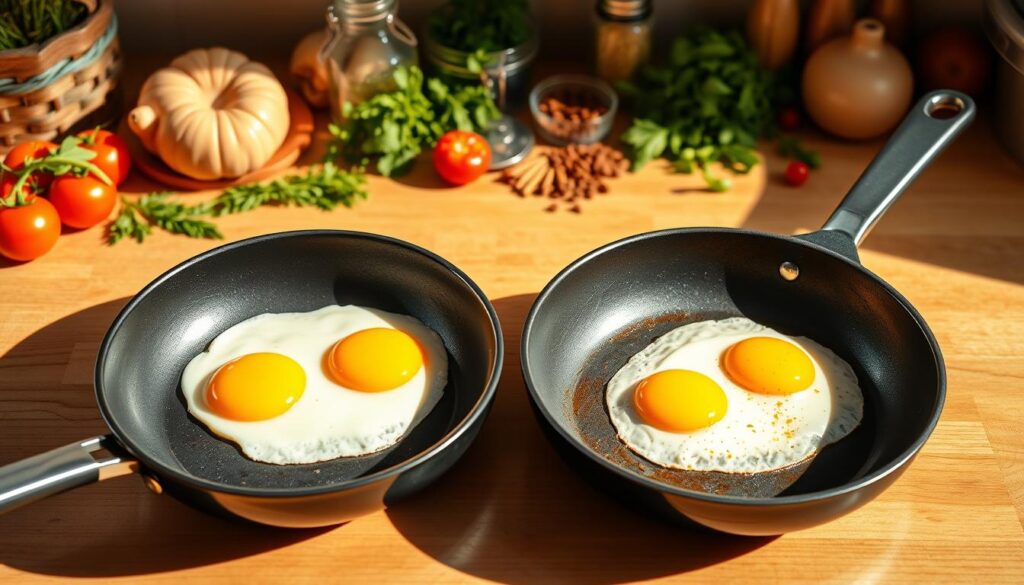
Understanding the differences lets you try different egg styles. You can find your favorite way to enjoy eggs. Whether you like a runny yolk or a fully set one, there’s an egg style for you.
| Egg Style | Cooking Method | Texture |
|---|---|---|
| Sunny Side Up | Cooked on one side | Runny yolk |
| Over Hard | Cooked on both sides | Fully set yolk |
The Art of Cooking Sunny Side Up Eggs -sunny side up vs over hard eggs-
Cooking sunny side up eggs needs care and a light touch. You must use the right tools and equipment. A non-stick pan is key to prevent eggs from sticking and make flipping easier.
It’s important to cook eggs until the whites are set and the yolks are just right. For sunny side up, yolks should be runny but slightly firmer in the middle. A thermometer helps check the egg’s temperature.
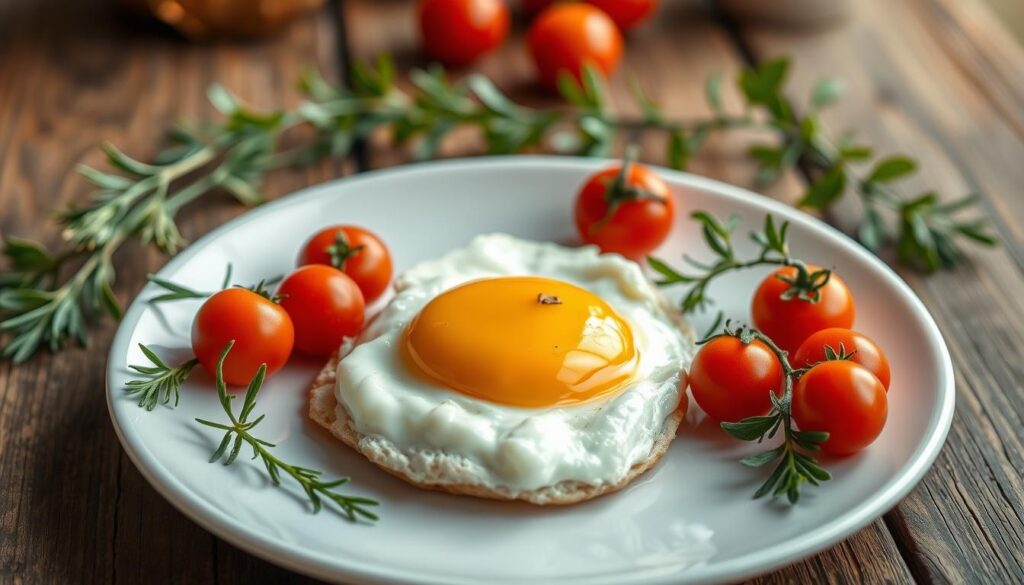
- Crack an egg into a non-stick pan coated with a small amount of oil or butter.
- Cook the egg over medium heat until the whites are set and the yolks are cooked to your desired level of doneness.
- Use a spatula to carefully lift and fold the edges of the egg towards the center, allowing the uncooked egg to flow to the edges.
By following these steps and using the right tools, you can make perfect sunny side up eggs. Always cook eggs to a safe internal temperature for food safety.
| Egg Doneness | Internal Temperature |
|---|---|
| Runny yolk | 145°F – 150°F |
| Soft yolk | 150°F – 155°F |
| Firm yolk | 155°F – 160°F |
Mastering Over Hard Eggs Technique -sunny side up vs over hard eggs-
To cook over hard eggs, you need to know the basics of egg cooking. Over hard eggs are a key part of many breakfasts. Learning how to cook them can make your breakfasts better. It’s all about controlling the heat and how you flip the eggs.
Heat control is crucial when cooking over hard eggs. You should use medium-low heat to cook the eggs slowly. This way, the yolk stays runny and the white sets right. When flipping the eggs, do it gently to keep the yolk intact.
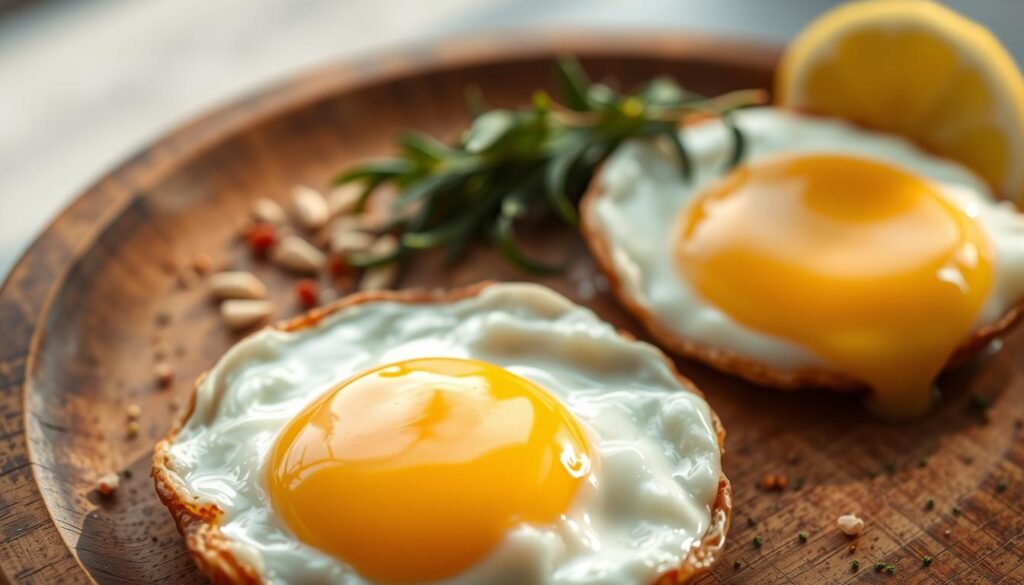
- Use a non-stick pan to prevent the eggs from sticking and to make flipping easier
- Cook the eggs over medium-low heat to control the cooking process
- Flip the eggs gently to prevent breaking the yolk
- Cook the eggs for an additional 30 seconds to 1 minute after flipping to set the yolk
By following these tips, you can make amazing breakfast dishes. Over hard eggs are perfect for any breakfast, whether it’s just for you or for a big group.
Essential Equipment for Perfect Fried Eggs -sunny side up vs over hard eggs-
Cooking perfect fried eggs needs the right tools. You want equipment that helps you get the perfect doneness and texture. Whether you’re new or experienced, knowing about different tools can improve your egg cooking.
You’ll need a good pan to start. Non-stick and cast-iron pans are top choices for eggs. Non-stick pans are best for soft eggs, while cast-iron pans give a crispy crust. Pick a pan that fits your cooking style and needs.
Pan Selection Guide
- Non-stick pans for delicate eggs
- Cast-iron pans for a crispy crust
- Stainless steel pans for durability
Temperature control tools are also key for perfect fried eggs. A thermometer ensures the right temperature, and a heat-resistant spatula makes flipping and removing eggs easy. With these tools, you’ll master egg cooking and get perfect fried eggs every time.
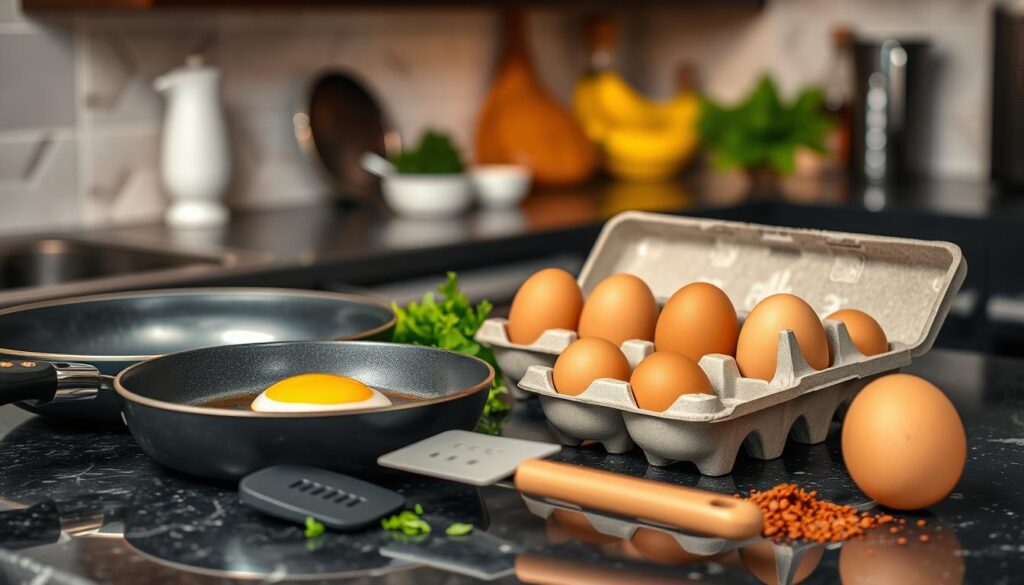
Temperature Control Tools -sunny side up vs over hard eggs-
A thermometer and heat-resistant spatula are essential for egg cooking. They help you get the perfect temperature and texture, making your fried eggs exceptional.
Common Mistakes to Avoid When Frying Eggs
Even the most skilled cooks can mess up when making breakfast eggs. To get the perfect fried eggs, it’s key to steer clear of common blunders. These include overcooking, undercooking, and using the wrong tools. Knowing these mistakes helps you fix your egg cooking styles and make tasty fried eggs every time.
Some common mistakes to watch out for include:
- Using low-quality pans that can’t distribute heat evenly
- Not adjusting the heat according to the type of eggs being cooked
- Not using the right amount of oil or butter
By knowing these mistakes, you can improve your egg cooking styles and make perfect fried eggs for your breakfast eggs. Remember, getting better takes practice, so don’t get discouraged if it takes a few tries.
To get even better at making fried eggs, try different egg cooking styles and techniques. With time and effort, you’ll become a pro at cooking breakfast eggs that will wow everyone.
| Egg Cooking Style | Description |
|---|---|
| Sunny Side Up | Cooked on one side, with the yolk still runny |
| Over Easy | Cooked on one side, then flipped and cooked for a short time on the other side |
| Over Hard | Cooked on one side, then flipped and cooked until the yolk is fully set |
Nutritional Comparison of Different Cooking Methods -sunny side up vs over hard eggs-
Choosing how to cook eggs can change their nutritional value. Fried eggs, for example, can have different calorie counts based on cooking style. Knowing these differences helps you make better diet choices.
Sunny side up eggs usually have fewer calories than over hard eggs. This is because sunny side up eggs cook for less time and absorb less oil. Over hard eggs, with their longer cooking time, might absorb more oil and have more calories.
Caloric Content Analysis
Looking closely at fried egg calories shows cooking method’s big impact. A study showed sunny side up eggs with minimal oil have about 70 calories. But over hard eggs cooked with more oil can have up to 120 calories.
Protein Structure Changes
How eggs are cooked can also change their protein structure. Overcooking eggs can make the proteins denature, affecting texture and nutritional value. Cooking eggs at lower heat helps keep the protein structure intact, preserving more nutrients.
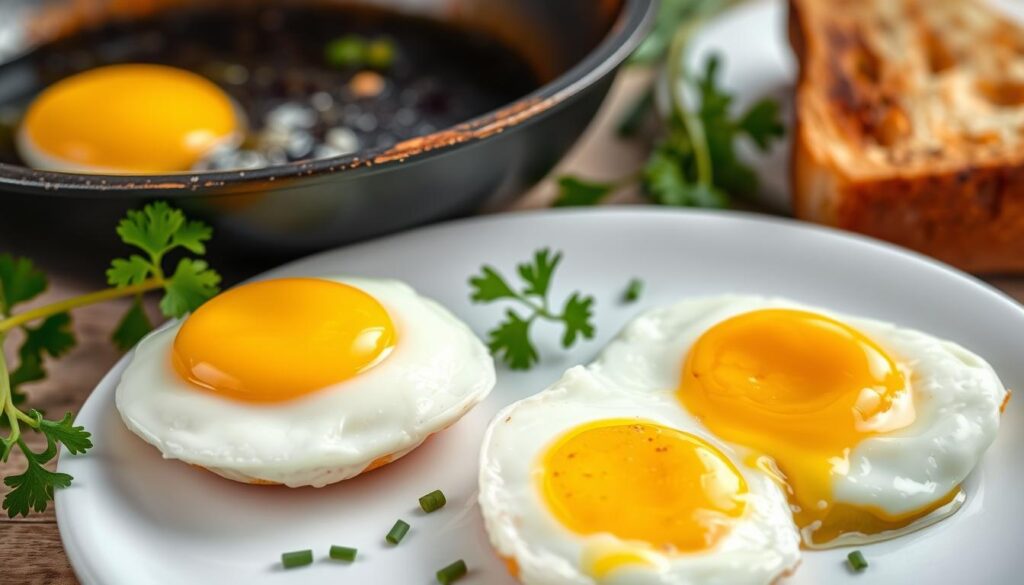
Vitamin Retention Rates
Vitamin retention is key when cooking eggs. Water-soluble vitamins like B and C can be lost in cooking, especially with overcooking. But poaching or soft-boiling eggs can help keep more of these vitamins, making your breakfast more nutritious.
Best Serving Suggestions and Pairings
There are many ways to serve sunny side up and over hard eggs. You can enjoy them with bacon, toast, and veggies for a classic breakfast. Or, add breakfast eggs to brunch favorites like eggs benedict or burritos.
Try sunny side up eggs with roasted veggies like asparagus or bell peppers. Over hard eggs are great with burgers or chicken sandwiches. Here are some ideas to start:
- Sunny side up eggs with smoked salmon and cream cheese on a bagel
- Over hard eggs with crispy bacon and cheddar cheese on a biscuit
- Breakfast eggs with sautéed spinach and mushrooms, served with whole grain toast
Exploring different ways to serve breakfast eggs is fun. Both sunny side up and over hard eggs offer protein and vitamins to kickstart your day.
With these ideas, you’ll make tasty meals with sunny side up, over hard eggs, and breakfast eggs. Be creative and enjoy your egg dishes every time!
| Egg Style | Popular Pairings | Nutritional Benefits |
|---|---|---|
| Sunny Side Up | Bacon, toast, vegetables | High protein, vitamin D |
| Over Hard Eggs | Burgers, chicken sandwiches, cheese | Good source of iron, vitamin B12 |
| Breakfast Eggs | Spinach, mushrooms, whole grain toast | Rich in vitamin A, fiber |
Professional Chef Tips for Perfect Eggs -sunny side up vs over hard eggs-
Professional chefs have mastered the art of cooking perfect fried eggs. They use special techniques to make their egg dishes stand out. Understanding different egg cooking styles, like sunny side up and over hard, is key.
Attention to detail is crucial when cooking eggs. Chefs focus on temperature control secrets to get it just right. A non-stick pan is best for fried eggs, as it prevents sticking and makes flipping easy.
Timing Techniques
Timing is everything in egg cooking. Chefs use timing techniques to cook eggs perfectly. Sunny side up eggs cook for less time than over hard eggs.
Seasoning Recommendations
Seasoning is vital for adding flavor to eggs. Chefs use seasoning recommendations like salt, pepper, and herbs. Paprika, garlic powder, and chili flakes are popular choices for fried eggs.
Follow these tips to make perfect fried eggs. Whether you’re cooking sunny side up or over hard, these methods ensure great taste and texture. Remember, the right temperature, timing, and seasoning are essential for a delicious egg dish.
- Cooking eggs requires attention to detail
- Temperature control is crucial
- Timing is everything when cooking eggs
- Seasoning can add flavor to egg dishes
| Egg Cooking Style | Temperature | Cooking Time |
|---|---|---|
| Sunny Side Up | Medium | 2-3 minutes |
| Over Hard | Medium-High | 4-5 minutes |
Health and Safety Considerations
When cooking eggs, especially fried eggs, safety is key. It’s important to avoid risks while exploring breakfast cooking methods. Handling eggs safely is crucial to prevent foodborne illnesses.
To handle eggs safely, store them in a cool, dry place. Always wash your hands before and after touching eggs. Use separate utensils and plates for raw and cooked eggs to prevent cross-contamination. Here are some key safety tips to keep in mind:
- Handle eggs gently to avoid cracking and potential contamination
- Wash eggs before storing them in the refrigerator
- Use a food thermometer to ensure eggs are cooked to a safe internal temperature
By following these simple guidelines, you can enjoy your favorite egg cooking styles, including fried eggs. This way, you can maintain a safe and healthy breakfast cooking environment. Always prioritize proper food handling and cooking techniques to minimize the risk of foodborne illnesses.
For more information on safe egg handling and cooking practices, consult reputable sources like the USDA or FDA. By staying informed and taking necessary precautions, you can enjoy your favorite egg dishes with confidence and peace of mind.
| Egg Handling Tips | Importance |
|---|---|
| Store eggs in a cool, dry place | Prevents bacterial growth and contamination |
| Wash hands before and after handling eggs | Prevents cross-contamination and foodborne illnesses |
| Cook eggs to a safe internal temperature | Ensures eggs are cooked thoroughly and safely |
Regional Variations and International Perspectives
Exploring egg cooking reveals unique approaches from around the world. Sunny side up to over hard eggs, each style reflects local tastes and traditions. American and European methods differ, with Americans preferring simple and Europeans exploring more.
Asian cuisine has greatly influenced egg cooking. It brings delicate steamed eggs and savory stir-fries to the table. You can add these international touches to your cooking by trying new seasonings and techniques.
Exploring Global Egg Dishes
- Shakshuka, a North African dish featuring eggs poached in a spicy tomato sauce
- Huevos rancheros, a Mexican breakfast dish with fried eggs, tortillas, and salsa
- Menemen, a Turkish scrambled egg dish with onions, tomatoes, and spices
Exploring these global egg dishes can broaden your culinary world. Whether you like sunny side up or over hard eggs, there’s much to discover.
Conclusion
Exploring sunny side up and over hard eggs shows us both have unique tastes. Sunny side up eggs have runny yolks and a soft texture. Over hard eggs are cooked fully, with no runny yolks.
Learning how to make these eggs can make your breakfasts better. You’ll impress everyone with your egg-cooking skills. Try different seasonings and ways to serve them to find what you like best.
Next time you cook eggs, enjoy the process and the taste. Bon appétit!
FAQ
What is the difference between sunny side up and over hard eggs?
Sunny side up eggs are cooked on one side, with a runny yolk. Over hard eggs are cooked on both sides, with a fully set yolk.
How do you cook sunny side up eggs?
Use a non-stick pan and gentle heat. Crack the eggs into the pan and cook without flipping. This way, the whites set while the yolks stay runny.
What’s the technique for cooking over hard eggs?
Start by cracking eggs into a hot pan. Cook on the first side until the whites are set. Then, flip and cook until the yolks are firm.
What equipment do I need for perfect fried eggs?
You’ll need a non-stick pan, a heat-resistant spatula, and a thermometer. These tools help achieve the right texture and doneness.
What are some common mistakes to avoid when frying eggs?
Avoid overcooking, undercooking, using the wrong pan, and not controlling the temperature. Pay attention to cooking time and use the right pan to prevent these mistakes.
How do the different cooking methods affect the nutritional value of eggs?
Cooking methods can change the nutritional content of eggs. Sunny side up eggs have more calories and fat because the yolks are runny. Over hard eggs have less calories because the yolks are fully cooked.
What are some of the best serving suggestions and pairings for fried eggs?
Fried eggs go well with many foods. Try them with bacon, toast, avocado, spinach, tomatoes, and cheese. They’re versatile and can be part of many meals.
What are some professional chef tips for cooking perfect eggs?
Chefs use precise temperature control, timing, and seasoning to cook perfect eggs. These tips can help you cook like a pro at home.
What are the health and safety considerations when cooking eggs?
Cooking eggs safely is crucial. Handle them properly to avoid foodborne illnesses. Make sure eggs are cooked to a safe temperature to kill bacteria.
Chicken Recipes:
- Kennedy Fried Chicken Recipe – Could be linked if your article mentions fried chicken or similar comfort foods.
- Kennedy Fried Chicken Menu – This could align well with discussions of grilled meats or dining experiences.
Italian-Inspired Dishes:
- Ground Turkey and Rice Recipes – Great for internal linking if you’re discussing pasta or hearty dishes similar to those served at the Macaroni Grill.
- Smothered Turkey Wings – May relate to similar flavorful meat dishes.
Restaurant Themes and Dining Experiences:
- Breakfast Restaurants Orlando – This could be useful if your article touches on different dining experiences similar to those found in Italian eateries like the Macaroni Grill.
- Pizza Edition – If you reference pizza, this link might help.

